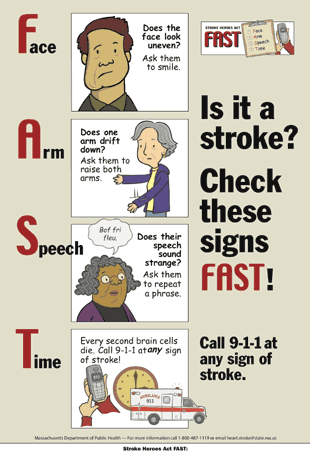A stroke or "brain attack" occurs when a blood clot blocks an artery (a blood vessel that carries blood from the heart to the body) or a blood vessel (a tube through which the blood moves through the body) breaks, interrupting blood flow to an area of the brain. When either of these things happen, brain cells begin to die and brain damage occurs.
When brain cells die during a stroke, abilities controlled by that area of the brain are lost. These abilities include speech, movement and memory. How a stroke patient is affected depends on where the stroke occurs in the brain and how much the brain is damaged.
Types of Stroke
there are two main types of stroke which is:-Ischemic Stroke
In everyday life, blood clotting is beneficial. When you are bleeding from a wound, blood clots work to slow and eventually stop the bleeding. In the case of stroke, however, blood clots are dangerous because they can block arteries and cut off blood flow, a process called ischemia.Absense of blood flow causes death of brain cells,eventually causing paralysis.Hemorrhagic Stroke
Strokes caused by the breakage or "blowout" of a blood vessel in the brain are called hemorrhagic strokes. The medical word for this type of breakage is hemorrhage. Hemorrhages can be caused by a number of disorders which affect the blood vessels, including long-standing high blood pressure and cerebral aneurysms. An aneurysm is a weak or thin spot on a blood vessel wall. These weak spots are usually present at birth. Aneurysms develop over a number of years and usually don't cause detectable problems until they break. There are two types of hemorrhagic stroke: subarachnoid and intracerebral.
In an intracerebral hemorrhage, bleeding occurs from vessels within the brain itself. Hypertension (high blood pressure) is the primary cause of this type of hemorrhage.
In a subarachnoid hemorrhage, an aneurysm bursts in a large artery on or near the thin, delicate membrane surrounding the brain. Blood spills into the area around the brain, which is filled with a protective fluid, causing the brain to be surrounded by blood-contaminated fluid.
Stroke Prevention
Know blood pressure (hypertension)
High blood pressure is a major stroke risk factor if left untreated. Have blood pressure checked yearly by a doctor or at health fairs, a local pharmacy or supermarket or with an automatic blood pressure machine.
Identify atrial fibrillation (Afib)
Afib is an abnormal heartbeat that can increase stroke risk by 500%. Afib can cause blood to pool in the heart and may form a clot and cause a stroke. A doctor must diagnose and treat Afib.
Stop smoking
Smoking doubles the risk of stroke. It damages blood vessel walls, speeds up artery clogging, raises blood pressure and makes the heart work harder.
Control alcohol use
Alcohol use has been linked to stroke in many studies. Most doctors recommend not drinking or drinking only in moderation - no more than two drinks each day.
Know cholesterol levels
Cholesterol is a fatty substance in blood that is made by the body. It also comes in food. High cholesterol levels can clog arteries and cause a stroke. See a doctor if your total cholesterol level is more than 200.
Control diabetes
Many people with diabetes have health problems that are also stroke risk factors. A doctor and dietician can help manage diabetes.
Manage exercise/diet
Excess weight strains the circulatory system. Exercise five times a week. Maintain a diet low in calories, salt, saturated and trans fats and cholesterol. Eat five servings of fruits and vegetables daily.
Treat circulation problems
Fatty deposits can block arteries carrying blood to the brain and lead to a stroke. Other problems such as sickle cell disease or severe anemia should be treated.
Transient Ischemic Attack (TIA)
A TIA is a temporary episode of stroke-like symptoms that can last a few minutes to 24 hours but usually causes no permanent damage or disability. TIA and stroke symptoms are the same. Recognizing and treating a TIA can reduce stroke risk. Up to 40 percent of people who experience a TIA may have a stroke.
How To Identify Stroke Before It Happens
Stroke symptoms include:
- SUDDEN numbness or weakness of face, arm or leg - especially on one side of the body.
- SUDDEN confusion, trouble speaking or understanding.
- SUDDEN trouble seeing in one or both eyes.
- SUDDEN trouble walking, dizziness, loss of balance or coordination.
- SUDDEN severe headache with no known cause.
Stroke can be prevented if the sign and symptoms can be detected earlier. Therefore each and every good samaritan should be aware on how to detect these signs and symptoms. Being in the know helps. So be safe and also watch out for others.Thank you.
